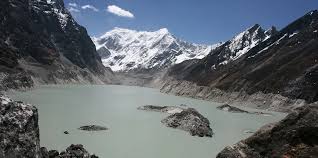PrashantNews
| A newly published scientific study provides the first comprehensive analysis of October 2023 devastating Glacial Lake outburst flood (GLOF) in South Lhonak Lake in Sikkim, which was quite similar to what happened in Chorabari lake near Kedarnath in June 2013.
The disaster resulted in 55 casualties, with 70 people still missing and caused extensive damage to critical infrastructure including hydropower facilities, bridges, highways, and buildings in the Teesta Valley. This event ranks among the most catastrophic GLOFs to hit the Himalaya in recent decades. Experts say GLOFs result in more damage and destruction than normal floods caused by heavy rains The research, led by a team of international scientists from nine countries, examines the triggers, dynamics, and cascading impacts of the flood, offering critical insight for Himalayan communities vulnerable to climate-induced disasters. Using high-resolution satellite imagery and modelling techniques, the study reveals that the GLOF was triggered by a collapse of up to 14.7 million cubic meters of frozen moraine material into the South Lhonak Lake. This collapse generated a tsunami-like wave approximately 20 meters high, which eroded the lake’s frontal moraine dam, releasing about 50 million cubic meters of water – equivalent to 20,000 Olympic sized swimming pools. “The South Lhonak GLOF serves as a grim reminder for similar high-risk lakes across the region,” said Ashim Sattar, Assistant Professor at Indian Institute of Technology Bhubaneshwar and lead author of the study. “We urgently need a multi-faceted approach, including early warning systems, strengthened regulatory frameworks, and community education, to mitigate these risks.” The flood severely impacted settlements and infrastructure along the Teesta River, breaching the Teesta III dam in Chunthang district. The study highlights the role of cascading hazards, where initial flooding triggered secondary landslides and debris flows, compounding the destruction. |
| Key recommendations from the study underscores:
1. Enhanced Early Warning Systems: Urgent implementation of improved hazard detection and response systems across the Himalaya. 2. Advanced GLOF Modelling: Current models often underestimate risks by failing to account for sediment entrainment and riverbank collapses. Improved techniques are critical for effective risk management. 3. Adaptative Risk Management: The recent disaster shows the need for urgent, adaptive plans, particular for basin-scale early warning systems. 4. Resilient Infrastructure: Strengthening regulations and risk assessments for hydropower projects near glacier lakes to safeguard communities and investments. |
| “This research paper exemplifies global collaboration among Earth scientists, using cutting-edge satellite imagery and modelling techniques to unravel the complexities of cryospheric hazards.” said Mohd. Farooq Azam, Intervention Manager, Cryosphere, ICIMOD, and a co-author of the study.
GLOFs occur when lakes fed by glacier melt release large volumes of water due to dam failures triggered by glacier calving, heavy rainfall, avalanche. These events pose increasing threats to mountain communities as climate change accelerates glacial retreat and destabilises moraine dams. “This study reveals how climate change is amplifying glacial hazards, with the 2023 Sikkim GLOF triggering an unprecedented cascade of destruction. It underscores the urgent need for better early warning systems, resilient infrastructure, stronger regional cooperation to mitigate future risks, and, most of all, faster action to switch to renewable energy especially among high emitting economies,” said Arun Shrestha, Senior Climate Change Specialist, ICIMOD. Published in the journal science, this study is a significant contribution to the growing body of research on climate change-driven cryosphere hazards. It provides crucial insights for policymakers, disaster response agencies and researchers to safeguard vulnerable mountain communities. |

